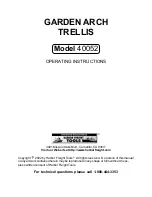
ABX Micros
ES60
OT/CT
4–30
User Manual - RAB237AEN
◆
Platelet aggregates
◆
Nucleated red blood cells
◆
This flag corresponds to the number of cells counted in the first channels, out of the total number
of lymphocytes.
2-
The "
M2
" flag indicates an excessive number of cells in the 130fl to 160fl zone. The pathological
elements which may be found in this area will include:
◆
Lymphoblasts
◆
Myelocytes
◆
Abnormal lymphocytes
◆
Basophilia (too many basophils)
◆
This flag corresponds to the number of cells counted in the detection zone in comparison to the
total number of granulocytes.
3-
The "
G1
" flag indicates an excessive number of cells in the 160fl to 220fl zone. The pathological
elements which may be found in this area will include:
◆
Eosinophilia (too many eosinophils).
◆
Myelocytes
◆
Neutrophil polynucleose
◆
This flag corresponds to the number of cells counted in the detection zone in comparison to the
total number of granulocytes.
4-
The "
G2
" flag indicates an excessive number of cells in the 220fl to 250fl zone. This flag makes
it possible to follow an abnormal granulocyte peak displacement. Some of the cell variances will
include:
◆
Anomalies in the cell membrane of the granulocytes.
◆
Possible lyse flow error.
◆
Fluidic errors.
◆
Old blood (after 6 to 8 hours) unrefrigerated.
◆
Granulocyte cell size less than 250fl.
5-
The "
G3
" flag indicates an excessive number of cells larger than 400fl. The pathological elements
which may be found in this area will include:
◆
Metamyelocytes.
◆
Many types of large immature cells.
◆
This flag corresponds to the number of cells counted in the detection zone in comparison to the
total number of granulocytes. This cell count will be higher than the set level.
All anomalies and/or abnormal distribution flags given by the instrument
should be manually verified by the examination of a stained peripheral blood
smear for the presence of pathological elements. As a result of the
differential resistance of cytoplasmic membranes in the different cell types,
pathological elements can be found in a number of different zones. This also
applies to the presence of normal or nonpathological cells that have been
subjected to chemotherapy or some other form of treatment which affects the
alarm zones. These types of treatment will result in "False" alarms.
Summary of Contents for ABX MICROS ES60
Page 1: ...Explore the future ABX Micros ES60 HAN706A 2007 HORIBA ABX User manual P n RAB237AEN...
Page 2: ......
Page 6: ...User Manual RAB237AEN...
Page 68: ...ABX Micros ES60 OT CT 3 12 User Manual RAB237AEN...
Page 116: ...ABX Micros ES60 OT CT 5 18 User Manual RAB237AEN Diag 5 21 LJ graphs printout example...
Page 128: ...ABX Micros ES60 OT CT 5 30 User Manual RAB237AEN...
Page 148: ...ABX Micros ES60 OT CT 6 20 User Manual RAB237AEN...
Page 196: ...ABX Micros ES60 OT CT 7 48 User Manual RAB237AEN...
















































